Back-to-school welcome from CCS Superintendent Lutz
Dear Currituck County Schools
Community,


Welcome to the 2023-2024 school year! We are thrilled to welcome back our students, faculty, and staff. We will continue our focus on learning and growing our students to be the best possible version of themselves. Some highlights for the 2023-2024 school year include:
Student Resource Officers are now in all ten of our schools. We are grateful for the support of our community members, County Commissioners, and Currituck County Sheriff’s Office. School safety and security are a top priority, and our parents and guardians can expect regular updates from our Student Services Department at our Board of Education meetings and continued transparency through release statements when threats at our schools are investigated.
Our Moyock Elementary School Panthers and Moyock Middle School Bulldogs will return this school year to larger, more accommodating campuses, including additional classrooms and cafeteria spaces. We are proud of the beautifully designed, purposeful learning spaces created for our students and appreciate the patience of our students, staff, and community while under construction for the past two school years.
We anticipate holding the Groundbreaking Ceremony for our future Tulls Creek Site in the late fall. The new elementary school has a capacity for 800 students and is scheduled for opening in the 2025-2026 school year. This will allow our county (which is one of the fastest growing counties in the state and nation) to meet the demands of increasing enrollments
and anticipated growth at our northern elementary schools. Our community can expect regular updates on this project, similar to those we provided monthly on the expansion projects.
Five Currituck County Schools proudly earned the Purple Star Award Designation from the North Carolina Department of Public Instruction for the 2022-2023 school year for demonstrating military-friendly practices and a commitment to military students and families. Our commitment and gratitude to our military students and families echo district-wide; therefore, this upcoming school year, we have set a goal to earn the District Purple Star Award, distinguishing all ten schools. We hope to share the news of meeting this distinction with our community in the spring semester.
District accreditation is rapidly moving forward. Cognia™ completed an on-site district visit in April 2023, touring some of our schools and meeting with stakeholder groups. After the visit, we received approval to move forward in the process, completing the Candidacy Phase. The next deadline in the process is in February 2024. We are confident that Currituck County Schools will be able to announce our full district accreditation before the close of our 2023-2024 school year.
The beginning of this school year marks Year 3 of our district strategic plan. We continue to strengthen our curriculum and practices, increasing our focus this year on the areas of Career and Technical Education (CTE), Exceptional Children (EC), and Academically or Intellectually Gifted (AIG). We will align resources for the social and emotional support
of our students and staff, prioritizing mental health and working towards increasing attendance. Our District Strategic Plan and plan progress updates are available to our community on our district website. A few final notes for our stakeholders:
Slight adjustments to our school start and end times have been made at the secondary level only. We believe the change made last school year to align our times across the district was beneficial, helping positively impact our student ride times, bus ridership, student discipline on buses, and retaining bus drivers. We appreciate and value the community feedback we received regarding this change.
We invite our stakeholders to join us throughout the coming school year at school events and Board of Education Meetings and to stay connected by visiting our website or following us on social media. We also encourage our families to use the Back-to-School Checklist provided in this letter and our online CCS Back-to-School Hub. We hope you find the checklist and online resources helpful in preparing for the upcoming school year. I am blessed to work with outstanding educators who put students first. The tremendous community support is at the heart of what makes the Currituck County School system a special place. Collectively, we are moving in the right direction and focusing on what’s truly most important, our children. We pledge always to put students first and continue striving for excellence. May the 2023-2024 school year be fun and rewarding for all!
Dr. Matthew Lutz Superintendent
BUS TRANSPORTATION
Refer to the Transportation Sheet (mailing the week of August 21st) for bus pick-up & drop off times, or Complete a Transportation Request Form if you wish to request transportation (to begin after the start of the school year)
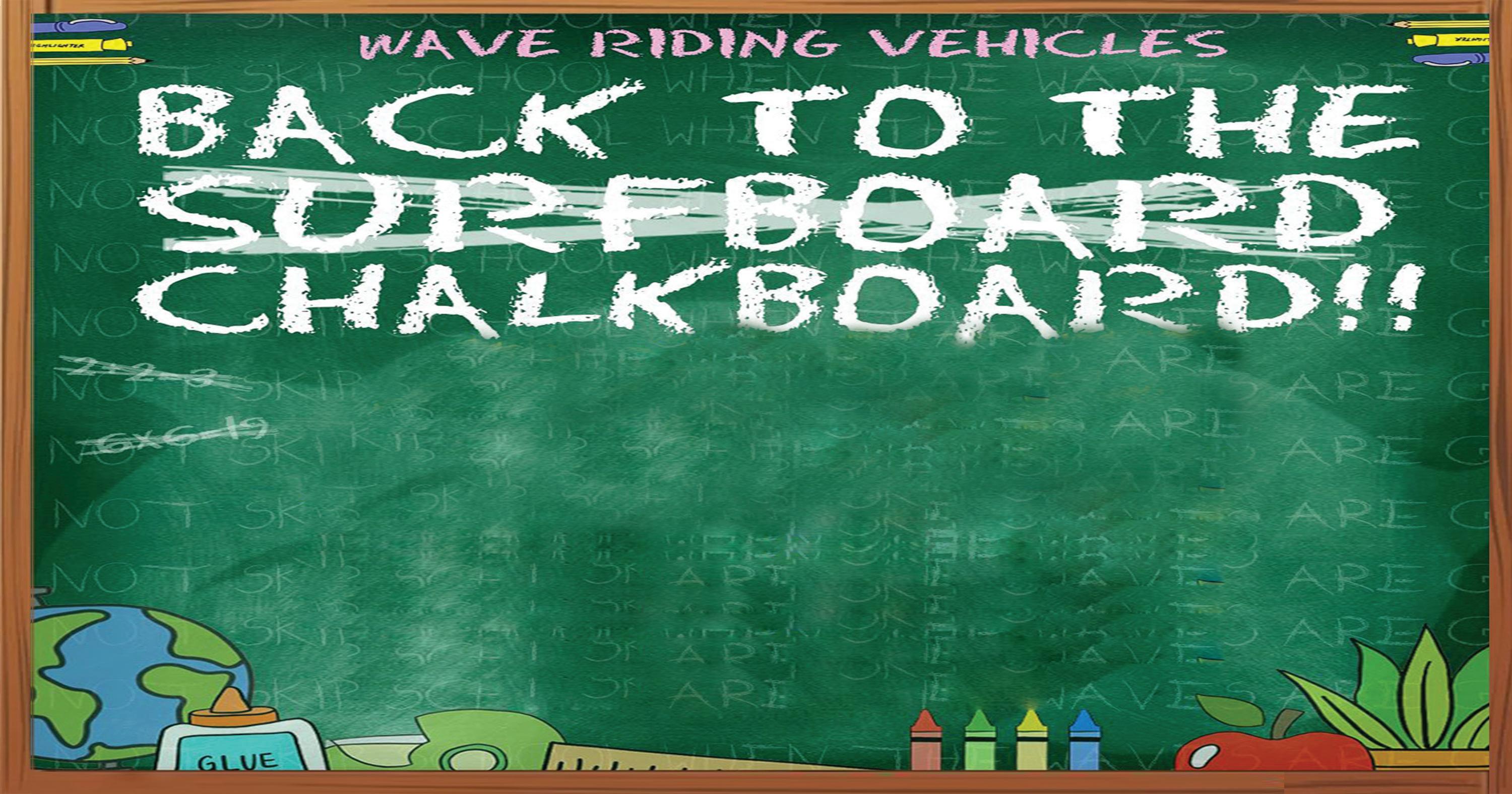
SCHOOL NUTRITION
Pre-pay school meal accounts using LINQConnect (formerly Titan). Students may also make payments in the form of cash or a check (made out to the school) in their school cafeteria. Complete a school meal application using LINQConnect (https:// linqconnect.com/)
• We encourage all families to complete the meal application
• Families receiving free or reduced meals last school year must complete a new application yearly. Last year’s status does not roll over and can only be honored for 30 days after the start of the new school year, including weekends. Please reapply as soon as possible and no later than Monday, September 25.
TECHNOLOGY

Download & Complete the CCS Technology Agreement Form






• This form is required for all students, including those electing to use their own devices.

Chromebook Fee Payment (acceptable forms


of payment include cash, checks made out to the school, or online payment in advance using SchoolCash Online)

HEALTH FORMS
Students will receive a green health form during the first week of school. Please complete and return this form as soon as possible.
CCS BACK-TO-SCHOOL ONLINE HUB



The following information is available for our families through our CCS Back-to-School Page. Access the hub from our website and social media, scan the QR Code, or type bit.ly/ccsback2school in your browser.

• School Supply Lists

• Open House Information
• School Calendars
• Schools Hours (Start, End, & Early Release Times)
• Bus Routes & CCS

Transportation Request Form

• Technology Form & Fee Information



• School Nutrition Meal
Application & Payment Information
• 2023-2024 Student
Parent Handbook
• SchoolCash Online




















Registration Information & Access
• Staying ConnectedWebsite & Social Media Information
• Getting Involved - Information on Volunteering, Substituting, or Becoming Employed with our Schools

THE COASTLAND TIMES 1B SUNDAY, AUGUST 27, 2023
2023-2024 BACK-TO-SCHOOL CHECKLIST
Back to School
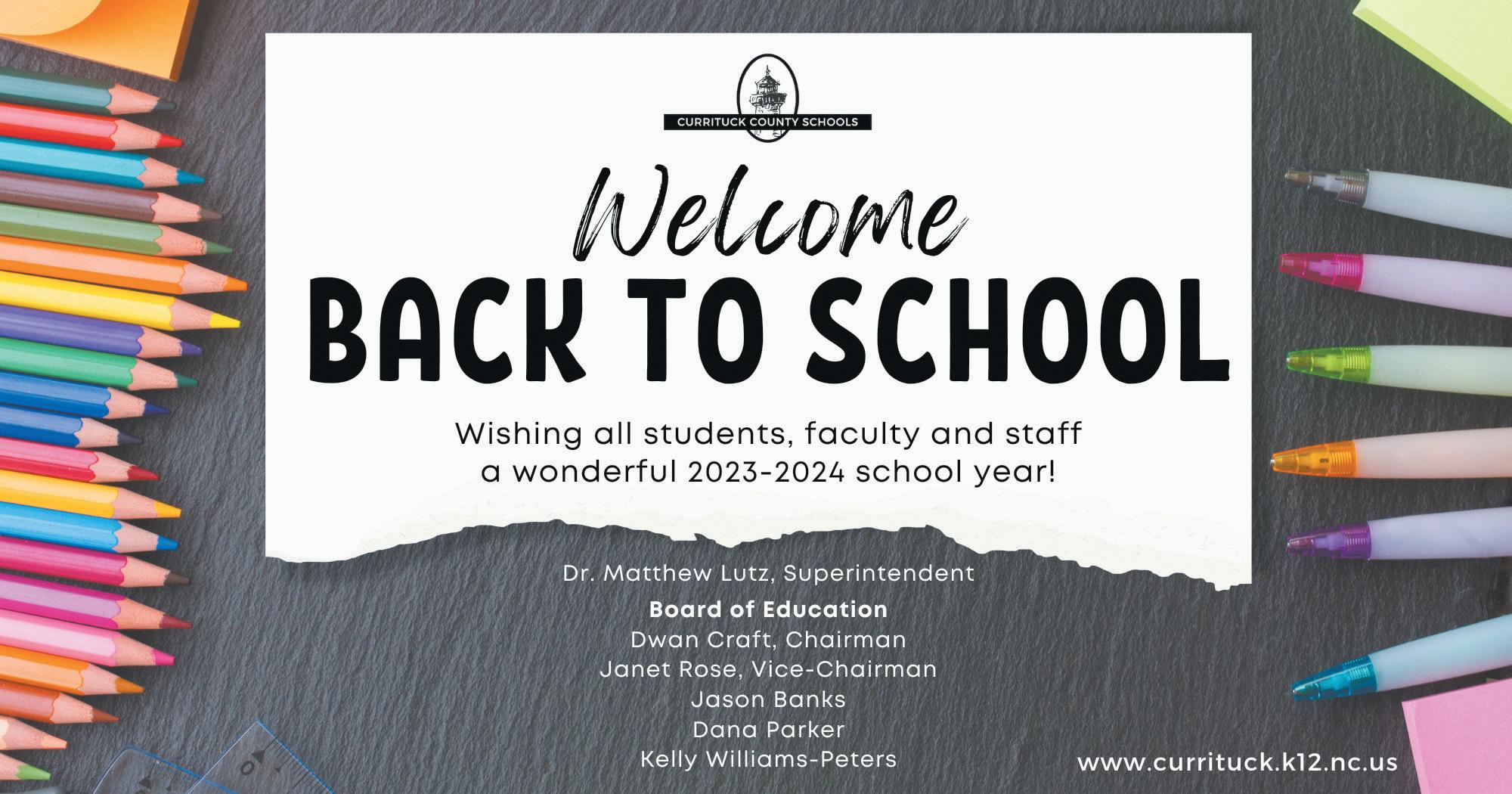
Enriching non-sports extracurricular activities
A school experience goes beyond lessons learned in the classroom. Part of what helps shape well-rounded students are the skills they sharpen and memories they make while engaging in extracurricular activities. Extracurricular

involvement shows that students can stick with activities for extended periods of time, indicates they have passions and interests, and illustrates that they can take initiative outside of their schoolwork. Athletics are popular
extracurricular activities. A love of sports often develops in elementary school, with children participating in recreational or school-based leagues each year. That enjoyment of the game only builds in middle school and high school. However, there are plenty of students who are not sports enthusiasts but still fill their after-school hours with activities that can help cultivate leadership, teamwork, time management skills, confidence, and much more. The following are some extracurriculars that go beyond the scholastic playing fields.
• Arts activities: These can include painting, sketching, ceramics, jewelry-making and yarn work.
• Band or chorus: Music instruction is ideal for those who want to explore a passion for singing or playing an instrument.
• Theater: Students can participate in theater productions after school. It’s possible to get involved both in front of the curtain and behind with positions in the cast, crew and even promotional team.
• Newspaper: Many schools still produce student-led newspapers in print or digital versions. Students handle all of the roles, from reporting, editing, photography and managing the publication.
• Foreign language clubs: Students may want to expand on their foreign language studies by participating in language clubs. Often these clubs include learning more about the cultures where specific languages are spoken, including exploring culinary delights and possible travel.

• Philanthropy: Like-minded students may want to participate in school-organized

volunteer activities. These keep students busy, but also benefit recipients in many ways. Activities can include beach sweeps or volunteering at animal shelters.
• Coding and programming: Students can learn the basics of writing code and building computer applications or websites.

• Culinary arts: Certain schools may be equipped with kitchen facilities and still offer elective courses in culinary arts, while others may reserve cooking classes to extracurricular activities. If a school does not have a culinary club, chances are students can find a cooking class offered through a private group.
There are plenty of extracurricular activities to engage students who are not interested in athletics. Students also can start new clubs if there are deficits in offerings at their schools.
Choosing the right backpack
Students need many different supplies to help them move to the head of the class. Teachers frequently post lists online before school begins or advise students in the early days of the new year. Therefore, parents may want to wait to go backto-school shopping until they learn what’s needed. There is one piece of gear, however, that students will definitely need: a backpack.
Backpacks have been helping students transport books and other materials to and from school for decades. Backpacks are not a new invention, and they actually predate school. Ötzi, a man whose mummified remains have been traced to the Copper Age, carried an animal fur rucksack during his travels. American Civil War soldiers carried bindles, and Henry Miriam developed one of the first knapsacks for the U.S military in 1877. It wasn’t until the late 1940s that kids started using backpacks for school, as more materials were available to make these bags after World War II. Backpacks are now ubiquitous on school campuses around the world. Backpacks are available in many different sizes and styles. Not all of them are created equal, and some may be better and safer for students than others. Here are some considerations:
• Look for even, secure stitching that will not come undone easily. Inexpensive backpacks may last a few weeks, but a more durable backpack can last the school year and beyond.
• Pass up backpacks with frayed fabric edges that could unravel, says
Consumer Reports.
• Opt for backpacks with zippers that have fabric flaps over them to keep water and other elements out of the backpack, helping prolong its life span.
• Consider a synthetic material, which will be lighter to carry and more resistant to water.
• Choose a backpack with lots of compartments that can spread the weight of gear out across the bag.
• Look for bags that have padded backs and straps. The padding should be ventilated, so the backpack will not get very hot when the child is using it.
• Karena Wu, a physical therapist and owner of ActiveCare Physical Therapy in New York, encourages parents to choose backpacks with tapered straps that will conform better to their children’s bodies. A waist strap can help keep the backpack centered on the child’s torso to help disperse the load.
• If the school allows it, a rolling bag is a great

way to prevent strain on the back. Verywell Family says children should carry no more than 15 percent of their bodyweight in the backpack. That means a 60-pound child shouldn’t carry more than 9 pounds.
• Select a backpack that is sized accordingly to the child. It may be tempting to buy the largest one around, but that can be cumbersome and the student may overload it.
• Many students now use laptops or tablets for school. It is a good idea to buy a backpack that has a padded pocket for tech devices to protect them during transport.
Although it may not seem trendy to do so, backpacks should always be worn with all straps in place to distribute weight evenly; otherwise, strain may be placed on one shoulder or side of the body. This, in addition to choosing the right backpack, can keep students comfortable and safe.
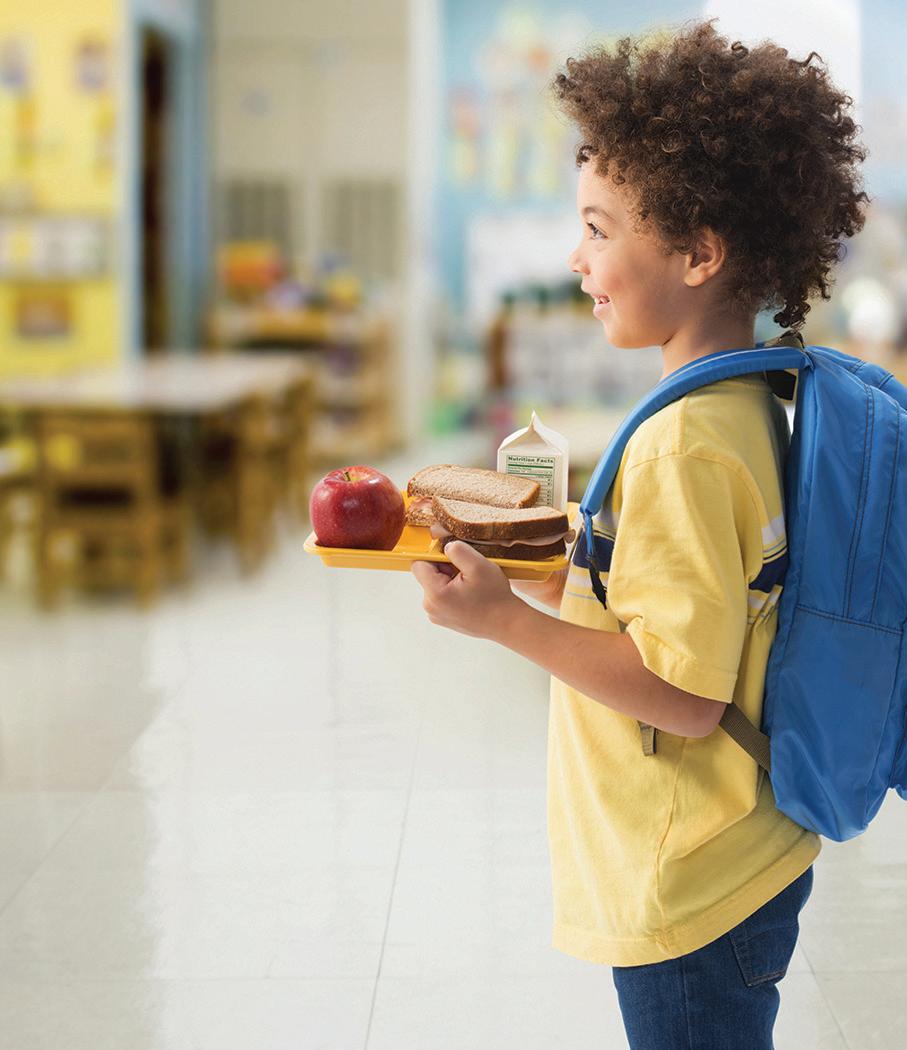
SUNDAY, AUGUST 27, 2023 THE COASTLAND TIMES 2B Welaome Baakto Sahool! Enjoy your "hump day" after school dinner at The J'olly Roger! Kids 12 and under eat FREE Wednesdays from 4-7pm (with purchase of adult dinners) Sept-Nov 252-441-6530 Restaurant & Bar MP 6 3/4, Kill Devil Hills, NC MP 6 3/4 • BEACH ROAD• KOH

SUNDAY, AUGUST 27, 2023 THE COASTLAND TIMES 3B
American Red Cross offers steps to help students
stay safe
Take special precautions with kids going to school for the first time
Soon students will head back to school, some entering the classroom for the first time. The American Red Cross North Carolina Region has offered 10 ways to help make sure students are safe as they head back to school for the upcoming year.
“There are some special steps parents of younger children should take, especially if kids are going to school for the first time,” said Allison Taylor, NC Regional CEO of humanitarian services. “They should make sure the child knows their phone number, address, how to get in touch with
their parents at work, how to get in touch with another trusted adult and how to dial 911. They should also make sure the child knows not to talk to strangers or accept rides from someone they don’t know.” Here are more steps to follow to help children stay safe:
• If students ride a bus to school, they should plan to get to their bus stop early and stand away from the curb while waiting for the bus to arrive.
• Students should board the bus only after it has come to a complete stop and the driver
or attendant has instructed them to get on. They should only board their bus, never an alternate one.
• All students should stay in clear view of the bus driver and never walk behind the bus.
• Cross the street at the corner, obey traffic signals and stay in the crosswalk.
• Never dart out into the street or cross between parked cars.
• If children go to school in a car, they should always wear a seat belt. Younger children should use car seats or booster seats until the lap-shoulder belt fits
properly (typically for children ages 8-12 and over 4’9”), and ride in the back seat until they are at least 13 years old.
• If a teenager is going to drive to school, parents should mandate that they use seat belts. Drivers should not use their cell phone to text or make calls and avoid eating or drinking while driving.
• Some students ride their bike to school. They should always wear a helmet and ride on the right, in the same direction as the traffic is going.
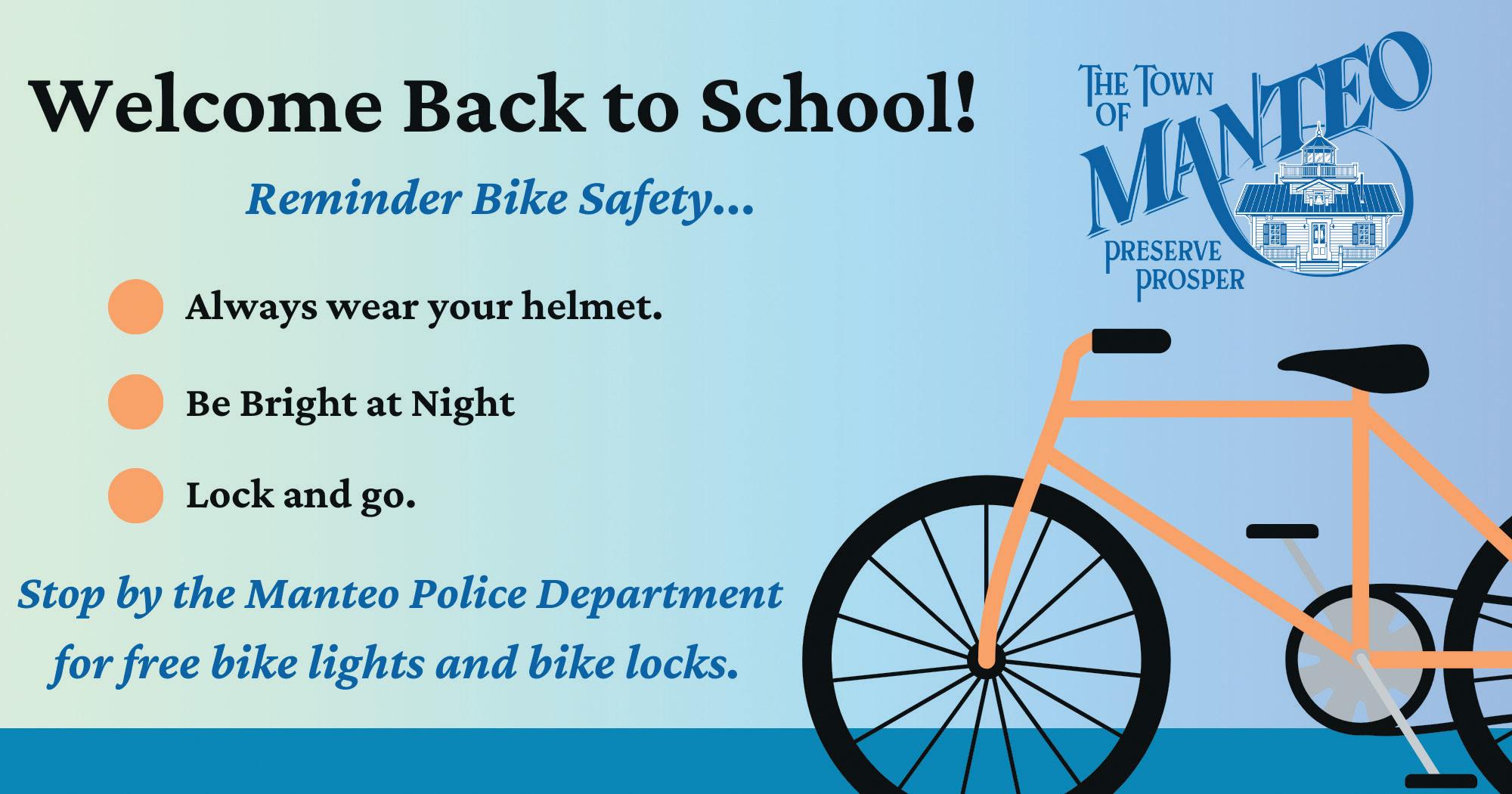
• When children are walking to school, they should only cross the street at an intersection, and use a route along which the school has placed crossing guards.
• Parents should walk young children to school, along with children taking new routes or attending new schools, at least for the first week to ensure they know how to get there safely. Arrange for students to walk to school with a friend or classmate.

DRIVERS, SLOW DOWN! Drivers should slow down as children head back to school. Know that yellow flashing lights indicate the bus is getting ready to stop and motorists should slow down and be prepared to stop. Red flashing lights and an extended stop sign indicate the bus is stopped and children are getting on or off.
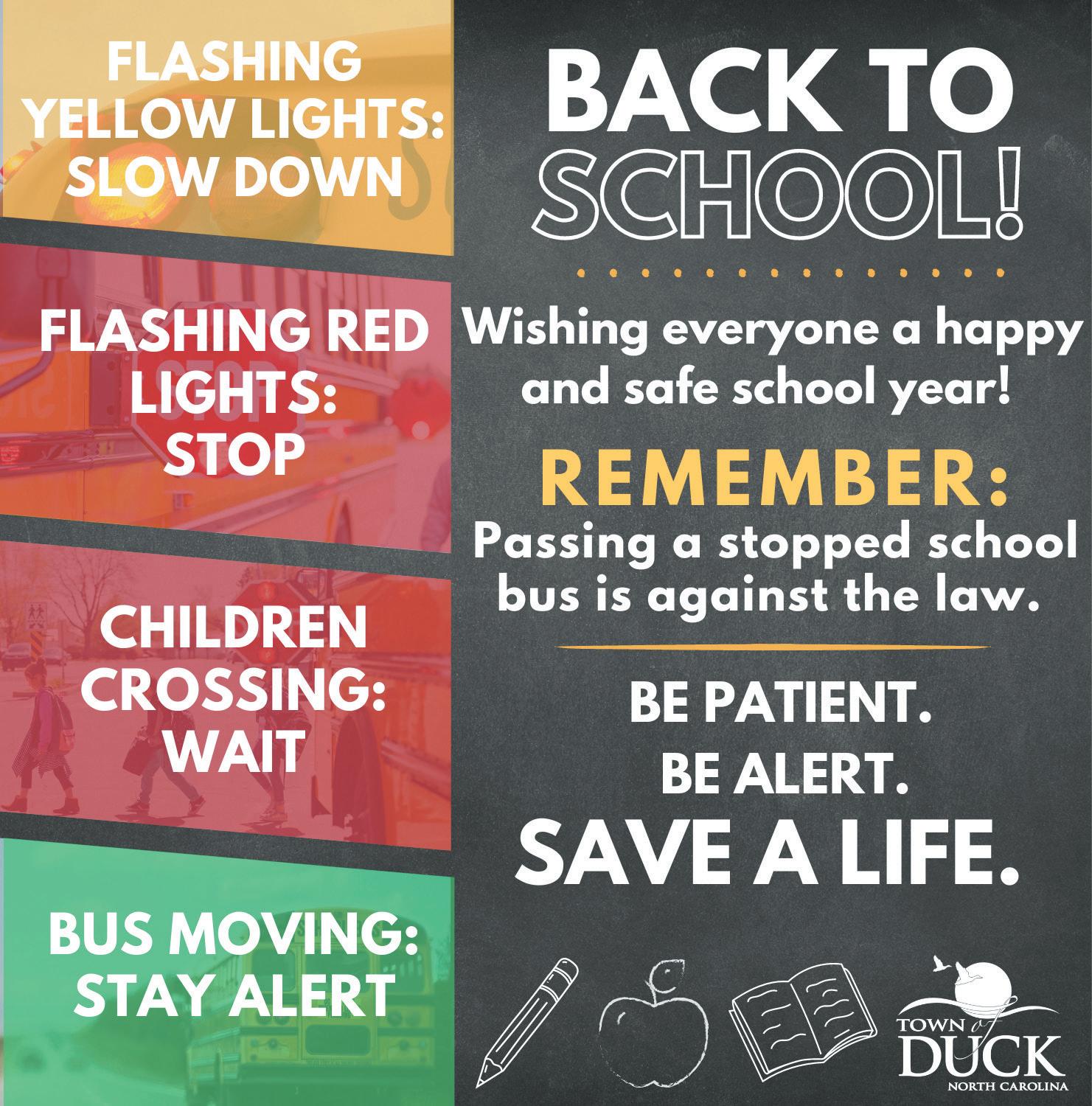
Motorists must stop when they are behind a bus, meeting the bus or approaching an intersection where a bus is stopped. Motorists following or traveling alongside a school bus must also stop until the red lights have stopped flashing, the stop arm is withdrawn, and all children have reached safety. This includes two and fourlane highways. If physical barriers such as grassy medians, guide rails or concrete median barriers separate oncoming traffic from the bus, motorists in the opposing lanes may proceed without stopping.
Do not proceed until all the children have reached a place of safety.
PREPARE FOR EMERGENCIES – Know what the emergency plan is at your child’s school in case a disaster or an unforeseen event occurs. Develop a family emergency plan so everyone will know who to contact and where to go if something happens while children are at school and parents are at work. Details are available at redcross.org/ prepare.
TAKE A FIRST AID CLASS – Learn and practice first aid and CPR skills by taking a course so you can help save a life. Download the free Red Cross First Aid app for instant access to information on handling the most common first aid emergencies whether it be before, during or after school. Find it by searching for ‘American Red Cross’ in the app store or at redcross.org/apps.
Strategies to help transfer students adjust to a new school
A new school year presents a wealth of opportunities for incoming students. Students returning to the same school can build upon the previous year’s successes, while students transitioning from elementary school to middle school or middle school to high school can embrace the excitement and accept the challenges posed by continuing on their academic journeys.
It’s not uncommon for all students to experience some first day jitters, but that nervous excitement might be especially
pronounced for transfer students. The transition to a new school is made simpler for many students because they make it alongside classmates they’ve known for years. Transfer students have no such security blanket, but can embrace the following strategies as they prepare to begin the school year in a whole new environment.
• Attend student orientation sessions. Orientation sessions can benefit any student, but may be especially useful for transfer students. Orientation sessions typically

include a campus tour, a rundown of both academic and social activities and a chance to meet the school staff, including teachers and coaches. Transfer students who attend these sessions also may meet fellow classmates, who typically serve as guides on campus tours or in other capacities which requires them to interact with session attendees. This can be a great opportunity to connect with individuals who could serve as a familiar
See Strategies, 5B
Back to School SUNDAY, AUGUST 27, 2023 THE COASTLAND TIMES 4B
What parents can do to be more involved at school

Parents can make every effort to encourage children to make the most of the school experience, including academics and extracurricular activities. Though students’ level of engagement is ultimately up to them, parental
involvement at school can be crucial for students’ success. According to the National Education Council, when parents get involved in their children’s education, those children are more likely to do better in
school and be more positive about the school experience. They also may be well-behaved. Parents wondering what they can do to assist at the school level can consider these possibilities: Attend school board












What parents can do to help prevent bullying
Bullying affects children from all walks of life. Whether the student is on the receiving end of bullying or is the aggressor, parents and other adults will sometimes need to step in to provide assistance. Although there is no magic formula to preventing bullying, parents can do their part to help put a stop to such behaviors.

• Parent authoritatively: According to developmental psychologist Diana Divecha, contributor to Greater Good magazine, an authoritative style of parenting offers high levels of warmth, love and closeness, while at the same time providing clear limits and high expectations. Children who are raised with this type of parenting often
Strategies, from 4B
face come the first day of school. • Schedule a visit with a guidance counselor. Guidance counselors can be invaluable resources for transfer students. Parents can come along and discuss the student’s interests in a direct conversation with a counselor, who can fill the family in on all that’s available on campus. That can include academics and extracurricular activities. • Dive in socially.
fare the best with better mental health and stronger relationship skills. Children who are parented harshly may be more likely to become bullies or be bullied themselves.


• Be knowledgeable and observant: Parents, teachers and administrators should keep their eyes peeled for bullying behaviors and reactions. Various signs indicate bullying is taking place, and these include being introverted, commonly reporting illness, withdrawing from daily activities, or having trouble sleeping.
















• Nurture a positive household climate: Parents and other family members can work together at home to create an organized and predictable environment.





Though it’s not always easy to transfer to a new school that already has its own social networks, the best way to meet new people is to make a concerted effort to engage socially. Student-athletes may have an advantage because the team atmosphere provides a readymade social network. However, extracurricular clubs also provide that benefit and do so without the added pressure of competing for a spot on a team.
• Don’t go it alone. Students should recognize that the transition is not something they need to do






Parents should model the type of behavior they want their children to express.
• Teach children coping skills: Practice scenarios at home where a child learns how to ignore a bully or develop assertive strategies for coping with bullying. Share who children can go to for help, apart from you, such as teachers or administrators, if they’re worried about being bullied.
• Set technology boundaries: Bullying can take place on social media and by monitoring online activity, parents may be able to head off potential bullying problems. Document online bullying so it can be addressed with administrators or law enforcement.

on their own. If students transferred because their family moved, then oth ers in the family, includ ing parents, are likely to experience their own ups and downs as well. Speak with parents and siblings if the transition does not get off to a smooth start. Such openness can open the door to new strategies and help to alleviate some of the stress that can accompany a transition to a new school.
A new school year can be a nervous time for transfer students. However, various strategies can help to make the transition go more smoothly.
meetings
Many community school boards are comprised entirely of volunteers who work with superintendents and other personnel to advocate for policies and procedures for students. Decisions typically are up for vote, and parents can run for school board positions or simply attend meetings each month and let their voices be heard about various issues.
Attend open houses and conferences




















Parents can make every effort to get to know teachers and other staff. Putting faces to names can help parents develop a connection to teachers and vice versa. Most schools have
back to school nights, meet the coaches opportunities, open houses, and parent-teacher conferences. Parents can take part in these events.
Open lines of communication









































































Parents can ask teachers and other staff how they prefer to communicate. Some teachers want students to take the lead and reach out first, with parents providing support if need be. Adults can be responsive when teachers reach out.
Attend school events
Families can make it a point to support students in all endeavors. Whenever the opportunity to visit the school comes up — whether for a concert,

sports game, trivia night, or fundraiser — parents can make an effort to attend.
Volunteer When parents want to be involved even further, they can head committees at school or volunteer with the PTA or PTO. They also can help out in the cafeteria, library or in the main office. Parents who have particular skills may volunteer to provide tutoring or mentoring as needed. Furthermore, parents can volunteer in school-sanctioned extracurriculars, such as Scouts BSA or as sports coaches. Involvement in school is part of being an informed and supportive parent.

SUNDAY, AUGUST 27, 2023 THE COASTLAND TIMES 5B
Back to School




































































































